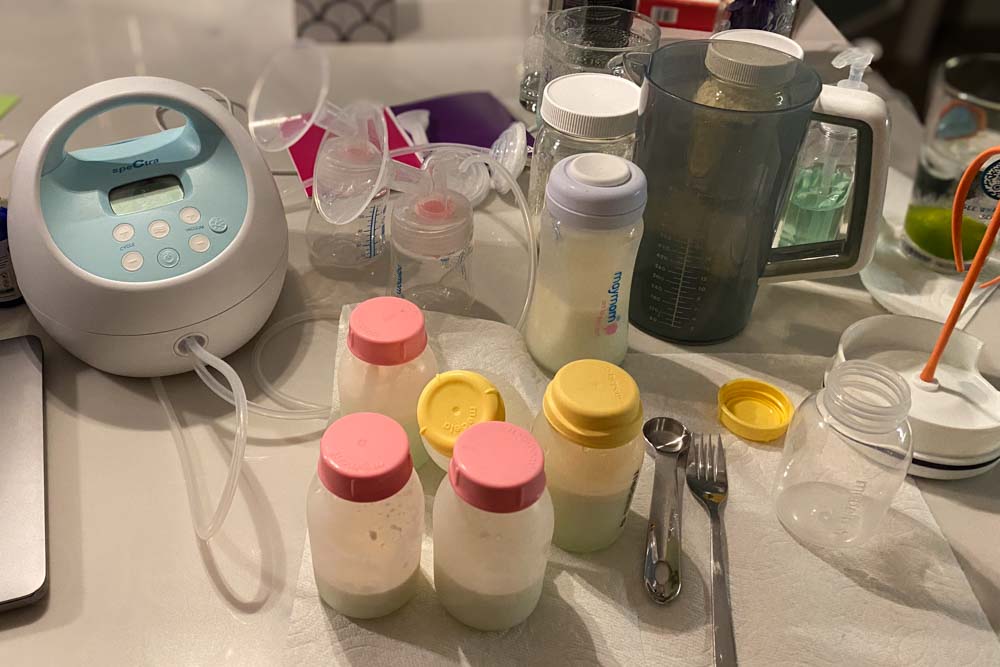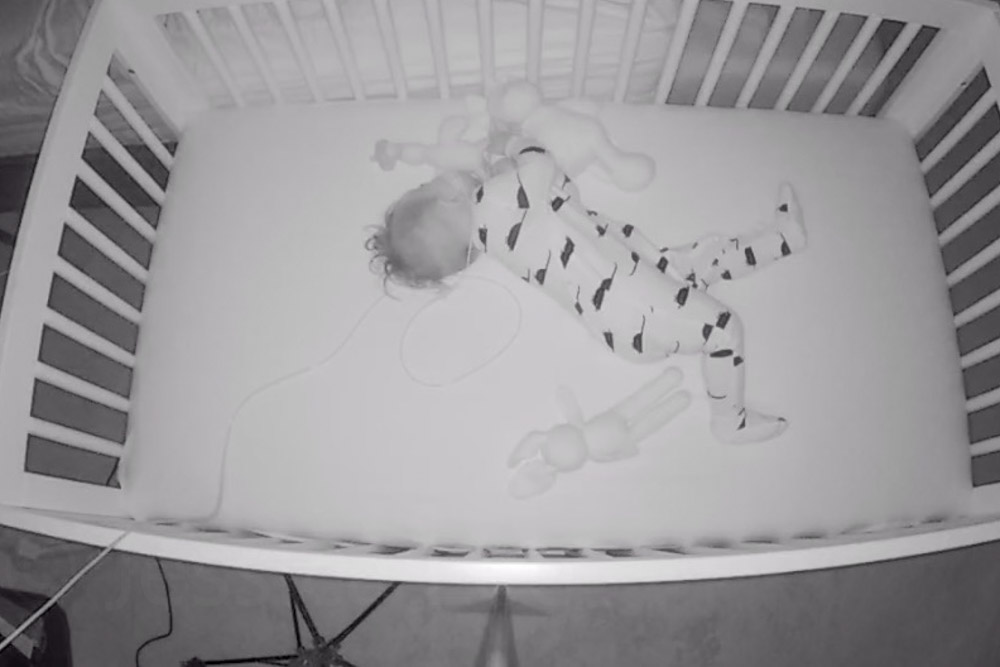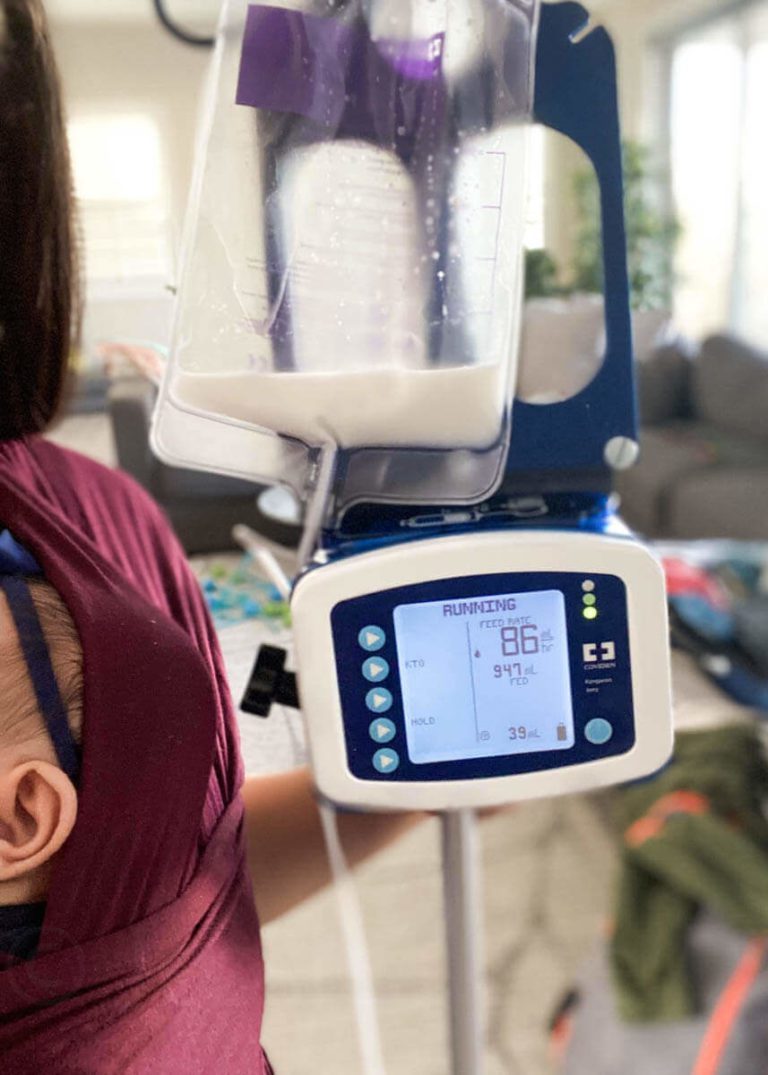Continuous Tube Feeding Overnight Routine for My Heart Baby
Five months into our tube feeding journey, we switched to continuous, which brought some much-needed relief overnight as we were running on empty. Continuous feeds are just as you might imagine, feeding continuously – nonstop.
My daughter was in interstage awaiting her second open heart surgery. We were struggling with severe reflux (i.e. GERD) and delayed gastric emptying (i.e. Gastroparesis). Getting her to gain weight was extremely difficult and critically important.
This was the next strategy we used and it helped bridge a gap. Let’s get into what exactly are continuous feeds, why a baby might do continuous tube feeding overnight, and how it all works.
No time to read right now? Pin it or email it to yourself for later!

Continuous Questions
What is continuous tube feeding?
Continuous tube feeding is when a tube-fed patient is provided their feeds (i.e. nutrition, milk, blended foods) ongoing without a break at an extra slow rate using a feeding pump for several hours.
The feeding pump pushes the contents through the bag’s tubing which is hooked up to the feeding tube’s port or extension. Their feeds are dripped super slowly into their stomach or intestine, depending on the type of feeding tube. Typically the rate is so slow it continues over many hours, such as over 10, 16, 20, or even a full 24 hours.
The feed may be paused occasionally to give a medication, for logistical, and other caretaking and troubleshooting needs. But this is normally a short pause and then the feed should resume.
Another way to think of it is if you were to gather all of your food for an entire day, then divide it up evenly, and then consume only a teeny tiny bite at a time and keep doing that for the entire day until you finish it all. This is how continuous feeds work, the person is consuming all (or nearly all) day long.
- Guide to Continuous Feeding for an NG Tube (by Boston Children’s Hospital)
- Guide to Continuous Feeding for a G-Tube (by Boston Children’s Hospital)
What are the alternatives?
Instead of continuous tube feeding, tube feeds can also be done intermittently, also known as bolus feeds. Bolus feeds can be given either by gravity (syringe or bag) or with a pump.
These options are both quicker and can be equated to eating snacks or meals that last 10-60 or so minutes.
- Guide to Bolus Feeding for an NG Tube (by Boston Children’s Hospital)
- Guide to Bolus Feeding for a G-Tube (by Boston Children’s Hospital)
Why would a baby need to do continuous tube feeding overnight?
There are numerous reasons why a baby could need to use a feeding tube. If a baby needs continuous feeds, it is likely due to their chronic or acute condition. The slow speed of feeding might be what their body requires either temporarily or permanently.
It could even be a way to temporarily problem-solve gastrointestinal upset, sleep needs, or due to other caregiver needs. Some families do continuous only overnight and use other tube feeding methods during the day.
Usually, a baby should not be on continuous feeds without a plan to transition off unless there is a diagnosed medical need necessitating strictly continuous feeding. This is something to be discussed with your child’s medical team to strategize a plan to accommodate their specific needs.
DISCLAIMER: The information provided on this blog is for general informational purposes only and should not be considered as professional advice. The content is not intended to be a substitute for professional medical advice, diagnosis, or treatment. Always seek the advice of your or your child’s physician or other qualified health provider with any question you may have regarding a medical condition. The author of this blog is not a doctor or a medical professional. The views expressed on this blog are based on personal experiences, research and general knowledge. Any reliance you place on the information from this blog is at your own risk. While every effort is made to provide accurate and up-to-date information, the author makes no representations or warranties of any kind, express or implied, about the completeness, accuracy, reliability, suitability, or availability of the information contained on this blog for any purpose.

Why we began continuous feeding overnight
My daughter was on bolus feeds for most of her NG journey. Due to increased vomiting and weight gain challenges (because of heart failure), however, we tested out an NJ tube to help mitigate these issues.
When we switched to an NJ, we also had to change to continuous feeding. For her specific needs, we had to shift to 24/7 feeds, so she was on continuous all day and all night. We did this for 1 month.
Our overnight routine
We were overworked, stressed, and maxed out on capacity for anything else. Caring for a heart warrior baby is intense. Trying to decide who to perform open-heart surgery on your infant tends to keep you up at night.
Thankfully moving to continuous overnight simplified my nighttime routine and cut a little stress. Continuous overnight feeds were far smoother for us than bolus feeding overnight. A tiny relief in the storm.
Here’s how I would usually go about my night while we were doing continuous feeds.
Prep
After my daughter was asleep, I would prep everything I might need for the night. This looked like prepping a stack of burp cloths and blankets for catching vomit (yes, seriously). I would prep tube tape supplies and other feeding tube supplies in case we lost the tube in the middle of the night (yes, this happened). We often needed a bulb syringe, wipes, and medications. Furthermore, I had typical baby supplies nearby for diapering and pumping.
Pump
At the end of the night, typically around 10 pm, I would pump one last time. I was exclusively pumping to provide my daughter breastmilk.
Often I would fall asleep during these night pumping sessions even while sitting at the counter.

Prepare the milk
Next, I would prep her milk for the next 12 or so hours. Most of the time we were fortifying to 24cal/oz, but closer to surgery we had to increase it to 26cal/oz. This was to provide her with greater calories in lesser volume since her body was only able to handle so much. Yet another strategy to help her gain weight.
I would mix my breastmilk with formula and separate it out into different bottles to store in the fridge for later.
This is NOT something you should try without explicit discussions and planning with your baby’s providers. Altering breastmilk and the liquid-to-powder formula ratio can be harmful and cause dehydration. This is only sometimes an option for medically complex babies and needs to be done under the care of a medical team who can help calculate and balance the ratio of liquids to formula to medications and consider all the variables of their condition.
Last meds and milk
Before going to sleep, I added all the milk my daughter would use overnight to her tube feeding bag. We used various ice pack setups to keep it cold through the night.
Lastly, I paused her pump to push her last medications of the night through her tubing. Then I restarted her pump.

Sleep
Finally, I got to doze off for a few hours, if she slept solidly.
Pump
At 3 am, I woke up to pump again. Maintaining a supply under all this stress and too little sleep was very challenging. I kept my middle-of-the-night pumping session for a long time to help.
Nap
After pumping, I would sleep for a couple more hours. My husband and I regularly traded off baby care in the middle of the night to help each other get at least a couple of hours of uninterrupted sleep.

Preparation was key to having a smoother night. Overall I don’t think I can say continuous feeding was easier or more difficult than bolus feeding. They both have their pros and cons.
At night time, however, continuous feeding was absolutely easier for us (not necessarily true for everyone). Bolus overnight included significant alarms, starting and stopping, rinsing and repeating. Switching to continuous overnight was so much easier with far fewer interruptions.
It afforded us the opportunity to get a tiny bit more sleep. And our daughter tolerated the slow rate better than bolus at this point in her journey.
Overnight feeding challenges to consider
Once we had the new routine down and strategized for the predictable kinks, it was smoother. There were things we had to problem-solve at the beginning. And there were still surprise challenges that popped up here and there.
If you’re discussing switching to overnight continuous feeds, consider and make a plan for the following:
- Discuss how long will they be on continuous feeds overnight
- How to make sure their feed tubing doesn’t get tangled and especially doesn’t get wrapped around their neck while sleeping
- How to keep the tubing clear and untangled so it doesn’t kink and cause an error
- Make sure the bag and tube are connected properly and will not detach
- Have the feeding pump set to the correct rate for continuous overnight
- Measure and pour the correct amount of milk in the feed bag for the entire night
- How to keep the milk at the proper safe temperature all night
- Keep the pump close enough to an outlet and plugged in if there is not enough battery life for the whole night
- Prepare for vomiting
- Know what to do if the tube comes out in the middle of the night
Final thoughts
I wouldn’t say either bolus feeds or continuous feeds were more difficult than the other, they both had their challenges and were just different. But I can say continuous tube feeding overnight was easier for our family than the alternative.
You should discuss with your child’s medical team if you want to consider continuous feeding overnight. There are different implications and it might not be appropriate for all situations.
If you plan to move to continuous overnight, prepare to address tangling, battery life, safe milk temperature, and tube troubleshooting. If all checks out for your tubie, their providers, and your family, then I hope you can enjoy slightly smoother nights!





